How Do You Know if You Have Ra
by Victoria Ruffing, R.N., C.C.R.P. and Clifton O. Bingham III, M.D.
- Epidemiology
- Clinical History
- Physical Exam
- Extra-Articular Disease
- Laboratory Tests
- Radiographic Findings
- Clinical Course
Epidemiology
Rheumatoid arthritis has a worldwide distribution with an estimated prevalence of 1 to two%. Prevalence increases with age, approaching v% in women over age 55. The boilerplate annual incidence in the United States is almost 70 per 100,000 annually. Both incidence and prevalence of rheumatoid arthritis are two to three times greater in women than in men. Although rheumatoid arthritis may present at any historic period, patients most unremarkably are start affected in the tertiary to sixth decades.
Clinical History
The typical case of rheumatoid arthritis begins insidiously, with the ho-hum evolution of signs and symptoms over weeks to months. Often the patient offset notices stiffness in one or more than joints, normally accompanied past hurting on movement and by tenderness in the joint. The number of joints involved is highly variable, but almost always the procedure is eventually polyarticular, involving five or more joints. Occasionally, patients feel an explosive polyarticular onset occurring over 24 to 48 hours. Another pattern is a palindromic presentation, in which patients describe swelling in one or two joints that may last a few days to weeks then completely go away, later to return in the same or other joints, with a blueprint increasing over time.
The joints involved near often are the proximal interphalangeal (PIP) and metacarpophalangeal (MCP) joints of the easily, the wrists, and small joints of the feet including the metatarsophalangeal (MTP) joints. The shoulders, elbows, knees, and ankles are too affected in many patients. The distal interphalangeal (DIP) joints are generally spared. With the exception of the cervical spine, the spine is unaffected.
Nonspecific systemic symptoms primarily fatigue, malaise, and low, may unremarkably precede other symptoms of the affliction by weeks to months and be indicators of ongoing disease activeness. Fatigue can be an peculiarly troubling characteristic of the disease for many patients. The blueprint of symptoms may wax and wane over the course of a solar day and fifty-fifty from ane day to the side by side. Sometimes "flares" of RA are experienced as an increment in these systemic symptoms more than discrete articulation swelling or tenderness. Fever occasionally occurs and is almost always low form (37° to 38°C; 99° to 100°F). A college fever suggests another illness, and infectious causes must be considered, specially in patients who are taking biological therapies and immunosuppressive medications.
Morning stiffness, persisting more one hour but often lasting several hours, may be a feature of any inflammatory arthritis simply is especially characteristic of rheumatoid arthritis. Its duration is a useful gauge of the inflammatory action of the disease. Similar stiffness tin can occur after long periods of sitting or inactivity (gel phenomenon). In contrast, patients with degenerative arthritis mutter of stiffness lasting merely a few minutes.
Physical Exam
Symmetrical joint swelling is feature of rheumatoid arthritis that has been persistent for a flow of fourth dimension. However when only a few joints are affected at the beginning of affliction, symmetry may not exist seen and should not preclude the diagnosis of RA. Careful palpation of the joints can help to distinguish the swelling of articulation inflammation from the bony enlargement seen in osteoarthritis, with the swelling ofttimes described equally being doughy or spongy in RA in dissimilarity to firm knobby enlargement in osteoarthritis. Swelling of the PIP and MCP joints of the easily is a common early on finding (Pictured beneath).Wrists, elbows, knees, ankles and MTP are other joints commonly affected where swelling is easily detected. Hurting on passive motion is a sensitive test for joint inflammation as is squeezing across the MCPs and MTPs. Occasionally inflamed joints will feel warm to the touch. Inflammation, structural deformity, or both may limit the range of motion of the joint. Over time, some patients with RA develop deformities in the hands or feet. RA spares the distal joints of the fingers (DIPs) and the spine with the exception of the cervical spine (especially the atlanto-axial joint at C1-C2), which may become involved specially with longer continuing illness.
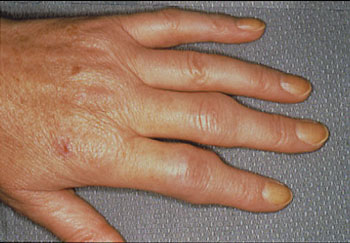
Reprinted from the Clinical Slide Collection on the Rheumatic Diseases, copyright 1991, 1995, 1997. Used by permission of the American College of Rheumatology.
Permanent deformity is an unwanted effect of the inflammatory process. Persistent tenosynovitis and synovitis leads to the formation of synovial cysts and to displaced or ruptured tendons. Extensor tendon rupture at the back of the mitt is a common and disabling problem.
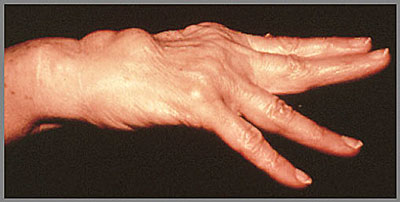
Reprinted from the Clinical Slide Collection on the Rheumatic Diseases, copyright 1991, 1995, 1997. Used by permission of the American Higher of Rheumatology.
Avant-garde changes in RA (shown below) include ulnar deviation of the fingers at the MCP joints, hyperextension or hyperflexion of the MCP and PIP joints, flexion contractures of the elbows, and subluxation of the carpal bones and toes (artsy -up).
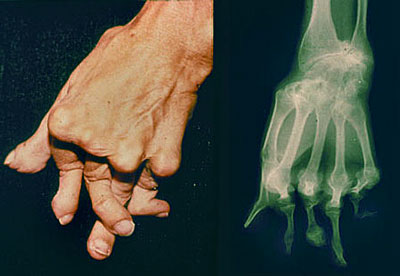
Reprinted from the Clinical Slide Collection on the Rheumatic Diseases, copyright 1991, 1995, 1997. Used by permission of the American Higher of Rheumatology.
Extra-Articular Disease
Although the joints are almost always the main focus of RA, other organ systems may also exist involved. Extra-articular manifestations of RA occur well-nigh ofttimes in seropositive patients with more severe joint disease. Extra-articular manifestations tin can develop even in disease when in that location is little agile articulation involvement.
Rheumatoid Nodules. The subcutaneous nodule is the most characteristic extra-articular lesion of the disease. Nodules occur in twenty to thirty% of cases, virtually exclusively in seropositive patients. They are located nearly usually on the extensor surfaces of the arms and elbows (shown below)but are also prone to develop at pressure points on the anxiety and knees. Rarely, nodules may ascend in visceral organs, such as the lungs, the centre, or the sclera of the center. (learn more about rheumatoid nodules in case written report #6)
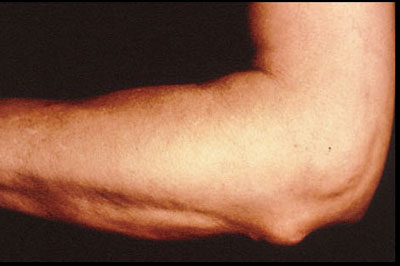
Reprinted from the Clinical Slide Drove on the Rheumatic Diseases, copyright 1991, 1995, 1997. Used by permission of the American College of Rheumatology.
Cardiopulmonary Disease. There are several pulmonary manifestations of rheumatoid arthritis, including pleurisy with or without effusion, intrapulmonary nodules, and diffuse interstitial fibrosis. On pulmonary function testing, in that location commonly is a restrictive ventilatory defect with reduced lung volumes and a decreased diffusing capacity for carbon monoxide. Although mostly asymptomatic, of greatest concern is distinguishing these manifestations from infection and tumor. (learn more about pulmonary complications in rheumatoid arthritis in case written report #six)
Atherosclerosis is the near common cardiovascular manifestation in rheumatoid arthritis. It is likewise the leading cause of death in the RA patient. Because chronic inflammation may exist the cause of atherosclerosis, information technology is possible that early ambitious treatment of RA may reduce the incidence or severity of heart disease. Pericarditis likewise seen with RA.
Eye Disease. Keratoconjunctivitis of Sjogren'due south syndrome is the most mutual ocular manifestation of rheumatoid arthritis. Sicca (dry eyes) is a common complaint. Episcleritis occurs occasionally and is manifested past mild pain and intense redness of the affected eye. Scleritis and corneal ulcerations are rare merely more serious problems.
Sjogren's Syndrome.Approximately 10 to fifteen% of patients with rheumatoid arthritis develop Sjogren'southward syndrome, a chronic inflammatory disorder characterized by lymphocytic infiltration of lacrimal and salivary glands. Sjogren's syndrome is an autoimmune status that affects exocrine gland part, leading to a reduction in tear production (keratoconjunctivitis sicca), oral dryness (xerostomia) with decreased saliva of poor quality, and reduced vaginal secretions. It is of import for patients to be seen regularly past the ophthalmologist and dentist. Additional medications are sometimes required to care for this condition. A polyclonal lymphoproliferative reaction characterized by lymphadenopathy is also seen, and patients take an increased risk of developing lymphoma. Additional information on Sjogren'south syndrome can exist institute at our Sjogren's Center website.
Rheumatoid Vasculitis. The most common clinical manifestations of vasculitis are small digital infarcts forth the nailbeds. (run across pic below) The abrupt onset of an ischemic mononeuropathy (mononeuritis multiplex) or progressive scleritis is typical of rheumatoid vasculitis. The syndrome ordinarily emerges after years of seropositive, persistently agile rheumatoid arthritis; however, vasculitis may occur when joints are inactive. Addional data on vasculitis tin exist found on our Vasculitis Heart website.
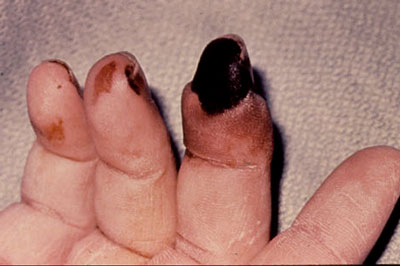
Reprinted from the Clinical Slide Drove on the Rheumatic Diseases, copyright 1991, 1995, 1997. Used by permission of the American College of Rheumatology.
Neurologic Disease.
The most common neurologic manifestation of rheumatoid arthritis is a mild, primarily sensory peripheral neuropathy, usually more marked in the lower extremities. Entrapment neuropathies (e.yard., carpal tunnel syndrome and tarsal tunnel syndrome) sometimes occur in patients with rheumatoid arthritis because of pinch of a peripheral nerve by inflamed edematous tissue. Cervical myelopathy secondary to atlantoaxial subluxation is an uncommon simply particularly worrisome complication potentially causing permanent, even fatal neurologic damage.
Felty'south Syndrome
Felty's syndrome is less commonly encountered than in the past. This is characterized by splenomegaly, and leukopenia – predominantly granulocytopenia. Recurrent bacterial infections and chronic refractory leg ulcers are the major complications.
Clinical Course
The grade of rheumatoid arthritis cannot exist predicted in a given patient. Several patterns of activity have been described:
- a spontaneous remission specially in the seronegative patient inside the kickoff 6 months of symptoms (less than 10%)
- recurrent explosive attacks followed past periods of quiescence virtually usually in the early phases
- the usual design of persistent and progressive disease activity that waxes and wanes in intensity.
Inability is college amid patients with rheumatoid arthritis with 60% existence unable to work ten years later on the onset of their disease. Recent studies have demonstrated an increased mortality in rheumatoid patients. Median life expectancy was shortened an average of vii years for men and three years for women compared to control populations. In more than than 5000 patients with rheumatoid arthritis from four centers, the mortality rate was ii times greater than in the command population. Patients at higher risk for shortened survival are those with systemic actress-articular involvement, low functional capacity, low socioeconomic status, depression instruction, and prednisone utilise. With the appearance of therapies to better control inflammation and treatment strategies geared to low disease activity and remission, it is hoped that the statistics concerning inability and mortality will improve.
Laboratory Tests
No laboratory examination volition definitively ostend a diagnosis of rheumatoid arthritis. However, the information from the following tests contributes to diagnosis and management.
- Complete blood count (CBC)
- Comprehensive metabolic panel (CMP)
- Rheumatoid Factor (RF)
- Antibodies to citrullinated peptides including anti-CCP
- Erythrocyte Sedimentation Rate (ESR)
- C-reactive protein (CRP)
The blood count shows a balmy anemia in approximately 25 to 35% of patients with RA. The white cell count is usually normal in patients with rheumatoid arthritis, but can be mildly elevated secondary to inflammation, and can also exist very low in a subgroup of patients with Felty'due south syndrome. Similarly, the platelet count is usually normal but thrombocytosis occurs in response to inflammation.
Chemical science tests are usually normal in rheumatoid arthritis with the exception of a slight decrease in albumin and increase in full protein reflecting the chronic inflammatory procedure. Renal and liver role are important to check before first treatment and are followed over time with many medications.
A positive rheumatoid gene is present in seventy-80% of patients with RA. A positive Anti-CCP is a more specific mark for RA and is found in similar proportions of patients over the grade of affliction. High levels of Anti-CCP also announced to be linked to a greater severity of the disease.
Measures of inflammation are often, but not e'er increased in RA. The erythrocyte sedimentation rate (ESR) is usually elevated in patients with RA and in some patients is a helpful adjunct in post-obit the activity of the affliction. The C-reactive protein (CRP) is some other measure of inflammation that is often elevated, and improves with command of disease activity.
Testing for hepatitis B and C and testing for tuberculosis are usually done every bit part of an initial evaluation. Baseline X-Rays of the easily, feet, and other afflicted joints are common at initial evaluation, and sometimes a baseline chest X-Ray is obtained.
Radiographic Findings
Erosions of os and destruction of cartilage, occur rapidly and may exist seen within the first 2 years of the illness, but continue to develop over time (See film below). These anatomic changes result in limitations in range of motion, flexion contractures, and subluxation (incomplete dislocation) of articulating bones. Typical deformities include ulnar deviation of the fingers at the MCP joints, hyperextension or hyperflexion of the MCP and PIP joints (swan neck and boutonniere deformities), flexion contractures of the elbows, and subluxation of the carpal bones and toes (hammer toes and cock up deformities). Radiological findings early in the disease may bear witness cypher other than soft tissue swelling. Thereafter, periarticular osteopenia may develop. With progression of their disease, narrowing of the joint space is caused by loss of cartilage, and juxta-articular erosions appear, more often than not at the signal of attachment of the synovium. In end-phase disease, large cystic erosions of bone may be seen.
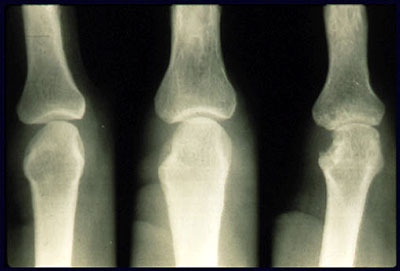
Reprinted from the Clinical Slide Collection on the Rheumatic Diseases, copyright 1991, 1995, 1997. Used by permission of the American Higher of Rheumatology.
More than recently the introduction of ultrasound and MRI imaging has imporved the sensitivity of detecting joint damage before in disease. Ultrasound may notice synovitis, effusions, and erosions, in improver to power Doppler providing estimates of ongoing inflammation. MRI may show inflammatory synovitis that enhances with Gadolinium and shows early erosions. The role for these modalities in following patients over fourth dimension in clinical exercise is still non well established, simply these methods may improve the ability to notice early illness and confirm a diagnosis.
Next: Pathophysiology of Rheumatoid Arthritis
buckinghamyind1946.blogspot.com
Source: https://www.hopkinsarthritis.org/arthritis-info/rheumatoid-arthritis/ra-symptoms/